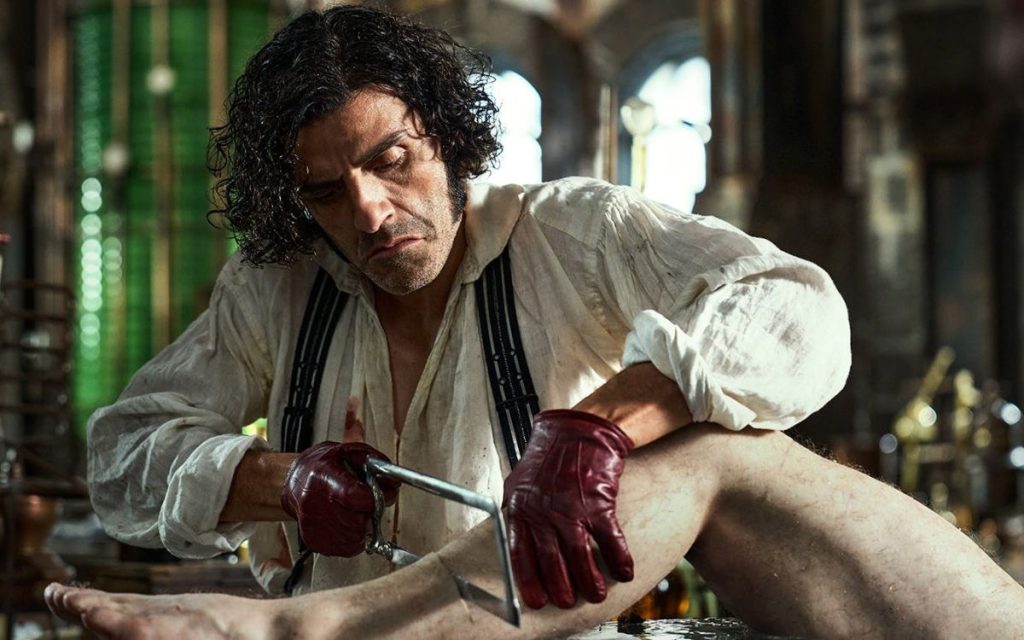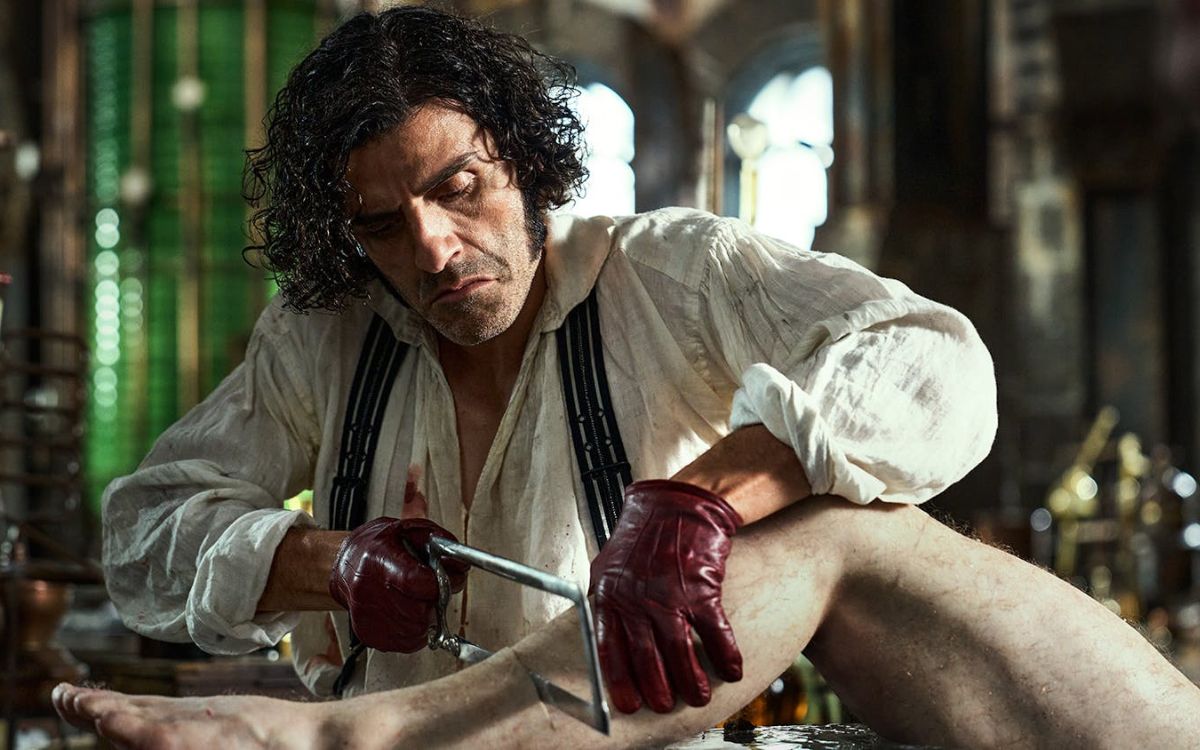Guillermo del Toro’s Frankenstein (2025) is the most faithful and emotionally resonant adaptation of Mary Shelley’s gothic masterpiece yet, writes CHRIS NEWTON
TITLE: Frankenstein
RELEASED: 30 August 2025 (Venice), 17 October 2025 (United States)
DIRECTOR: Guillermo del Toro
CAST: Oscar Isaac, Jacob Elordi, Mia Goth, Christoph Waltz
Review of Frankenstein 2025
In 1823, five years after the anonymous publication of Frankenstein, Mary Shelley wrote that she found herself famous after attending a stage production based on her novel.
‘Presumption; or, the Fate of Frankenstein’ was adapted by Richard Brinsley Peake and, in many ways, it set the precedent for every adaptation of Mary Shelley’s legendary novel that followed.
In Peake’s telling of the tale, Frankenstein’s Creature – who is articulate and eloquent in the novel – is rendered mute, just as Karloff’s iconic portrayal of the Creature would be in James Whale’s 1931 Frankenstein movie for Universal Pictures.
This same film gave us the immortal line, ‘It’s Alive!’ Whilst that line does not appear in the book, in Presumption… Victor Frankenstein proclaims, ‘It lives!’ upon seeing his creation animated.
Much like the 1924 Dracula stage play, the version of Frankenstein which entered the public consciousness seems to owe less to Mary Shelley than it does to Richard Brinsley Peake.
Interestingly, the Creature, portrayed on stage by Mr T. P. Cooke, was credited in the cast list as simply ‘———’, prefiguring Karloff’s mysterious credit as ‘?’ in the first Universal film.
1994’s Mary Shelley’s Frankenstein, directed by and starring Kenneth Branagh, was touted as a ‘faithful’ version, though its heightened melodrama was really little more than a desperate attempt to cash in on the success of Bram Stoker’s Dracula (1992).

Dracula screenwriter James V. Hart had been slated to also adapt Frankenstein, before difficulties with the project led to him producing instead.
Script duties for that film were handed to Steph Lady, and then eventually to Frank Darabont, who described Mary Shelley’s Frankenstein as ‘the best film I ever wrote and the worst film I ever saw’.
That film arguably looked like Shelley’s novel, but it didn’t feel like it.
Now, 207 years after Frankenstein’s publication, legendary filmmaker Guillermo del Toro brings us a two-and-a-half-hour sumptuous gothic banquet that’s probably the closest anyone has yet come to realising Mary Shelley’s vision.
Like the novel, the film begins in the frozen Arctic wastes in the 19th century, as an intrepid captain (in this iteration, Captain Anderson, played by Lars Mikkelsen, not the Captain Walton of the book) tries to find a passage to the North Pole.
Trapped in the ice, the crew come across a dying Victor Frankenstein (Oscar Isaac) who is brought on board to relate his tale to Anderson.
The film gives us an elaborate backstory for Victor and his relationship with his brilliant but abusive father, played by Charles Dance with all the cold ruthlessness of Tywin Lannister.
When Victor’s mother dies delivering William, Victor vows to conquer death and discover the secrets of immortal life.
There are some deviations from the source material, though.
It is not Germany, but Edinburgh, where Victor goes to complete his education, and whilst Professor Krempe has a brief appearance (played by Ralph Ineson), it is an original character, Henrich Harlander (Christoph Waltz), who encourages and funds Victor’s experiments.
The character adds little to the overall story, and seems to serve only as a means to introduce his niece, Elizabeth (Mia Goth).
In most major adaptations, Elizabeth and Victor are engaged, as they are in the novel.
Their marriage is short-lived after the Creature (denied his request for a mate by his creator) murders the bride of Frankenstein on their wedding night.
However, in this iteration, it is William Frankenstein, not Victor, to whom Elizabeth is engaged (making her a sort of sister-in-law to Victor, rather than adopted sister, as she is in later versions of the novel).
Goth’s Elizabeth, and her relationship with the Creature, is one of the highlights of the film, and the somewhat unnecessary subplot about Henrich’s motivations for aiding Victor only seems to slow the film down and rob us of screen time which could have been given to Goth.
The other major change is that, in the novel, William is a child.
Here, he is a young man who works with and visits his older brother.
It seems that del Toro has combined the characters of Henry Clerval (who is absent from this adaptation) and William.
Readers of the novel will know that the Creature – spurned by his creator and by society at large – swears unholy vengeance on Frankenstein and brutally murders the young William in cold blood.
It is interesting, then, that this irredeemable act of infanticide is absent from del Toro’s telling of the tale, which offers us a Frankenstein that gives its monster, and possibly also its creator, a hope of redemption.
For the first half, this feels like a film which doesn’t quite know where it is going or what it wants to be, but when the Creature climbs on board Anderson’s ship and insists on giving the captain his account, it all comes together perfectly.
Jacob Elordi steals the show and gives us the only on-screen portrayal of the Creature that matches Mary Shelley’s description, even down to his yellow eyes and long black hair.
Yet, his performance is not merely one of aesthetic authenticity – the Creature is barely described in the novel – Elordi captures the Creature’s entire range, from his confused newborn innocence, his delight and fascination with nature and beauty, his abject horror at the cruelty of humanity, his desperate loneliness, and his murderous, vengeful rage.
Elordi has all of Boris Karloff’s vulnerability, and Christopher Lee’s menace, but with the Creature’s sensitive side which has only ever truly been present in the book.
This movie is a love letter to Frankenstein as a concept – from the visual nods to Hammer with the Creature’s bandages, and a scene in which he is shot in the face and clutches at his bleeding eye in a nod to Christopher Lee; the location of Frankenstein’s laboratory in a gothic castle reminiscent of the Universal classic; the Creature reciting Percy Bysshe Shelley’s Ozymandias as he learns to read.
It’s impossible to see Edinburgh – even an Edinburgh of 200 years ago – without thinking of the legendary Frankenstein Bier Keller on George IV Bridge.
Even Elizabeth’s look seems to channel Mary Shelley herself, and it’s hard not to read her as Shelley – the only person who truly sees the Creature’s delicate, poetic soul.
Indeed, as William’s fiancée, she is the ‘Bride of Frankenstein’, drawing parallels with the fact that Elsa Lanchester portrayed both the Bride and Mary Shelley in Universal’s famous 1935 sequel.
We could argue whether or not the Universal Frankenstein movies are technically better films than this latest version – no monster design will ever be as iconic as Karloff’s, no dialogue will ever come close to ‘It’s Aliiiive!’ – and no depiction of the Bride could hope to rival Elsa Lanchester.
But here, del Toro has given us a Frankenstein movie that not only preserves the anatomical heart of Mary Shelley’s story but reanimates it with new vibrant life, proving that – like Elordi’s Creature – Frankenstein will never die!



